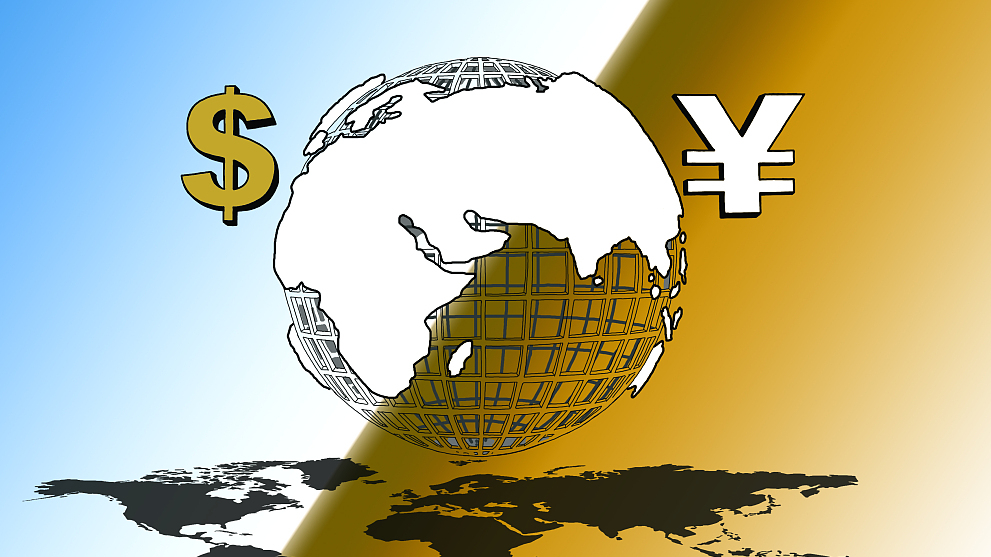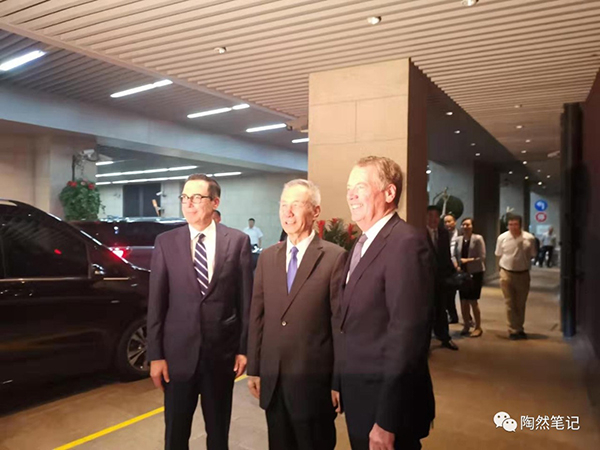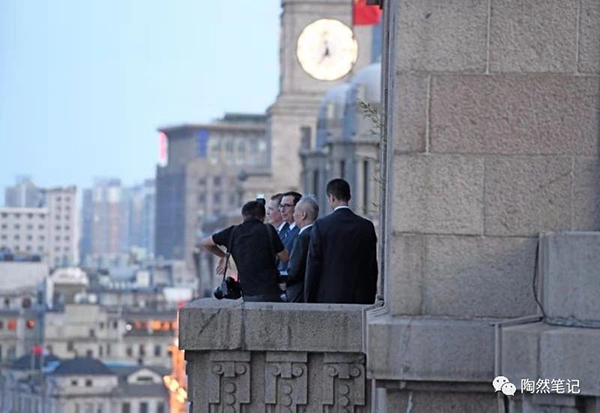

Editor's note: This article is an edited translation which was first published on Taoran Notes, a Wechat official account platform. The article reflects the author's opinions and not necessarily the views of CGTN.
On July 31, the 12th round of Sino-U.S. high-level economic and trade consultations was completed in Shanghai. On the evening of July 30, Chinese and U.S. delegations had a brief working dinner at the famous Fairmont Peace Hotel.
According to a report in The Paper, Chinese Vice Premier Liu He, U.S. Trade Representative Robert Lighthizer and U.S. Treasury Secretary Steven Mnuchin appeared on the terrace on the 9th floor of the Fairmont Peace Hotel and enjoyed the view of the Huangpu River. It's worth noting that Liu He, Lighthizer and Mnuchin also turned around and posed for a photo on the terrace with the night view of Lujiazui as the background.
The name of the place where the negotiations resume also makes people think: Will the resumption of negotiations at the Fairmont Peace Hotel reboot the Sino-U.S. economic and trade cooperation?
After three months of tense relations starting in early May, China and the United States finally return to the negotiation table. However, the differences between the two countries still linger. In this case, talking in a different venue may refresh the mood of both sides. It can be seen from the facial expressions of the guests and the host that the atmosphere at the scene was quite easy.

Chinese Vice Premier Liu He, U.S. Trade Representative Robert Lighthizer and U.S. Treasury Secretary Steven Mnuchin pose for a photo in front of the hotel, Shanghai, China, July 30, 2019. /Photo via Taoran Notes
Shanghai is the most dynamic city in China and among the most well-known Chinese cities to people in the West. Restarting the negotiations there can not only send the signal that "politics is politics, and trade is trade" but also help to ease the tension. Second, this will let the U.S. feel the opportunities presented by China more intuitively and weigh the advantages of "talk" against the disadvantages of "confrontation."
Shanghai is one of the important windows through which the world can observe China's economy. China's market and opportunities can be most directly felt there. The U.S. is well aware of the opportunities in the Chinese market.
What's more, the expanded areas of the China (Shanghai) Pilot Free Trade Zone are about to launch. Some analysts say that the expanded areas can offer more opportunities for the expansion of Sino-U.S. trade, as they are expected to try out more innovative policies in investment and trade liberalization, better investment and operations access, free movement of goods, uninterrupted capital flow, highly open transportation, free flow of human resources, fast information connection, and so on. They will also explore more competitive tax arrangements against the prevailing international practices.
Everyone hopes that the spirit of the 1972 Sino-U.S. Joint Communique, also known as the Shanghai Communique, can be invoked during this talk, especially the wisdom and vision enshrined in the Communique.
On February 27, 1972, then Chinese Premier Zhou Enlai and then U.S. President Nixon signed the Joint Communique of the People's Republic of China and the United States of America in Shanghai and issued it on February 28.
The Shanghai Communique is an important milestone in the history of Sino-U.S. relations and international relations. It not only marks the end of 22 years of alienation between the two countries and the beginning of normalization of bilateral relations but also has a positive and far-reaching impact on the situation in the Asia-Pacific region and the world. Simply put, the Shanghai Communique has opened the door to the normalization of Sino-U.S. relations.

Liu He, Lighthizer and Mnuchin look out from the terrace of the Fairmont Peace Hotel in Shanghai, China, July 30, 2019. /Photo via Taoran Notes
When the venue of the talk is set in Shanghai, many people at home and abroad mentioned this Communique to make sense of the choice of meeting place. However, two important things were missing.
First, as a turning point in the normalization of Sino-U.S. relations, the Shanghai Communique was the result of historical development. Before that, China and the United States had basically fallen out. Under the international situation at that time, Nixon's visit to China and the Shanghai Communique only came after China and the United States had exhausted all other ways of approaching each other except for cooperation.
So, it is not groundless when we say China and the United States stand to gain from cooperation and lose from confrontation.
Second, the Shanghai Communique also implies the way China and the United States get along with each other in history.
According to Nixon, "this Communique broke diplomatic ground by stating frankly the significant differences between the two sides on major issues rather than smoothing them over. Thus the text is surprisingly lively for a diplomatic document."
Both sides do not shy away from the differences and express them openly. Confrontations cannot outweigh common interests, in the spirit of which both sides seek common ground while shelving differences.
The Shanghai Communique harbors exceptional wisdom and vision between the lines. In light of the two points stated above, it will be beneficial to both sides if the spirit of the Shanghai Communique can be invoked in the following negotiations.
However, it takes two to tango. The sincerity that China expresses can only be truly conducive to the progress of the negotiations after the United States gives a positive response.
(If you want to contribute and have specific expertise, please contact us at opinions@cgtn.com.)

Copyright © 2018 CGTN. Beijing ICP prepared NO.16065310-3
Copyright © 2018 CGTN. Beijing ICP prepared NO.16065310-3